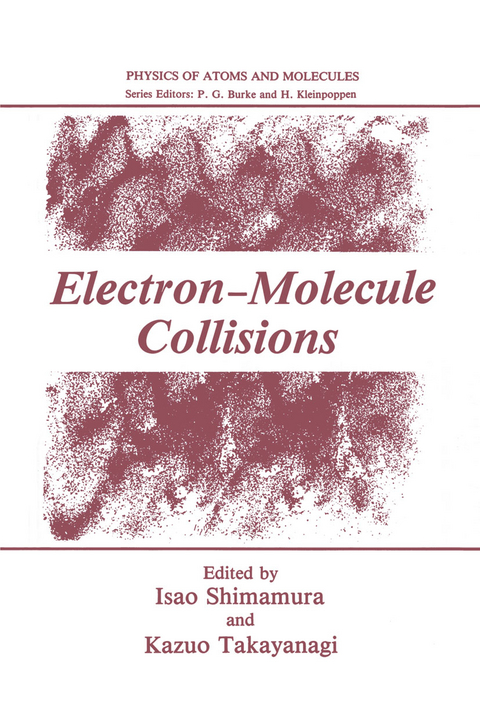
Electron-Molecule Collisions
Kluwer Academic/Plenum Publishers (Verlag)
978-0-306-41531-9 (ISBN)
Scattering phenomena play an important role in modern physics. Many significant discoveries have been made through collision experiments. Amongst diverse kinds of collision systems, this book sheds light on the collision of an electron with a molecule. The electron-molecule collision provides a basic scattering problem. It is scattering by a nonspherical, multicentered composite particle with its centers having degrees of freedom of motion. The molecule can even disintegrate, Le., dissociate or ionize into fragments, some or all of which may also be molecules. Although it is a difficult problem, the recent theoretical, experimental, and computational progress has been so significant as to warrant publication of a book that specializes in this field. The progress owes partly to technical develop ments in measurements and computations. No less important has been the great and continuing stimulus from such fields of application as astrophysics, the physics of the earth's upper atmosphere, laser physics, radiation physics, the physics of gas discharges, magnetohydrodynamic power generation, and so on. This book aims at introducing the reader to the problem of electron molecule collisions, elucidating the physics behind the phenomena, and review ing, to some extent, up-to-date important results. This book should be appropri ate for graduate reading in physics and chemistry. We also believe that investi gators in atomic and molecular physics will benefit much from this book.
1. Introduction to Electron-Molecule Collisions.- 1. Introduction.- 2. Cross Sections.- 3. Electron-Molecule Interactions.- 4. Resonance Effect.- 5. Calculation of the Total Cross Section as a Potential Scattering Problem.- 6. Theoretical Formulation of Inelastic Scattering Processes.- 2. Rotational Excitation of Molecules by Slow Electrons.- 1. Introduction.- 2. Classical Sudden Collisions and Angular-Momentum Transfer.- 3. Quantum-Mechanical Sudden Collisions and Angular-Momentum Transfer.- 4. Division of the Configuration Space.- 5. Physics in the Potential Scattering Region.- 6. Physics in the Compound-System Region.- Appendix: Summary of Formulas.- References and Notes.- 3. Vibrational Excitation of Molecules by Slow Electrons.- 1. Introduction.- 2. Virtual States and Resonances.- 3. Vibrational Excitation. I: Wave-Function Enhancement without Trapping.- 4. Vibrational Excitation. II: Electron Scattering at a Shape Resonance; Impulse Limit.- 5. Vibrational Excitation. III: Long-Lived Resonances and Nuclear Relaxation.- 6. Current Developments.- Appendix A: Resonance Scattering of Electrons by a Target with Fixed Nuclei.- Appendix B: Resonance Scattering of an Electron by a Molecule with Relaxing Nuclei.- Appendix C: The Impulse Approximation.- Appendix D: Wave Packets.- References and Notes.- 4. Dissociation of Molecules by Slow Electrons.- 1. Introduction.- 2. Dissociation of Molecules into Ground Electronic State Fragments.- 3. Dissociation into Excited Fragments.- 4. Dissociative Ionization.- 5. Dissociative Attachment.- 6. Dissociative Attachment to Ultracold Molecules and Molecular Clusters.- 7. Dissociative Recombination.- References and Notes.- 5. Molecular Spectroscopy By Electron Scattering.- 1. Introduction.- 2. Resonance Spectroscopy of Molecules.- 3. Electron Energy-Loss Spectroscopy.- References.- 6. Experimental Techniques for Cross-Section Measurements.- 1. Introduction.- 2. Definition of Cross Sections.- 3. Measurement of Total, Integral, and Momentum-Transfer Cross Sections.- 4. Measurement of Differential Cross Sections.- 5. Electron Collision Measurements at High Energies; Generation of Optical Data.- 6. Electron Scattering in Electromagnetic Fields.- 7. Closing Remarks.- References.- 7. Computational Methods for Low-Energy Electron-Molecule Collisions.- 1. Introduction.- 2. Derivation of the Radial Equations.- 3. Numerical Solution of the Fixed-Nuclei Equations.- 4. Vibrational Excitation and Dissociative Attachment.- 5. Electronic Excitation.- 6. Conclusions.- References.
| Erscheint lt. Verlag | 31.12.1984 |
|---|---|
| Reihe/Serie | Physics of Atoms and Molecules |
| Zusatzinfo | XIV, 570 p. |
| Verlagsort | New York |
| Sprache | englisch |
| Maße | 155 x 235 mm |
| Themenwelt | Naturwissenschaften ► Chemie ► Physikalische Chemie |
| Naturwissenschaften ► Physik / Astronomie ► Atom- / Kern- / Molekularphysik | |
| ISBN-10 | 0-306-41531-3 / 0306415313 |
| ISBN-13 | 978-0-306-41531-9 / 9780306415319 |
| Zustand | Neuware |
| Haben Sie eine Frage zum Produkt? |
aus dem Bereich


